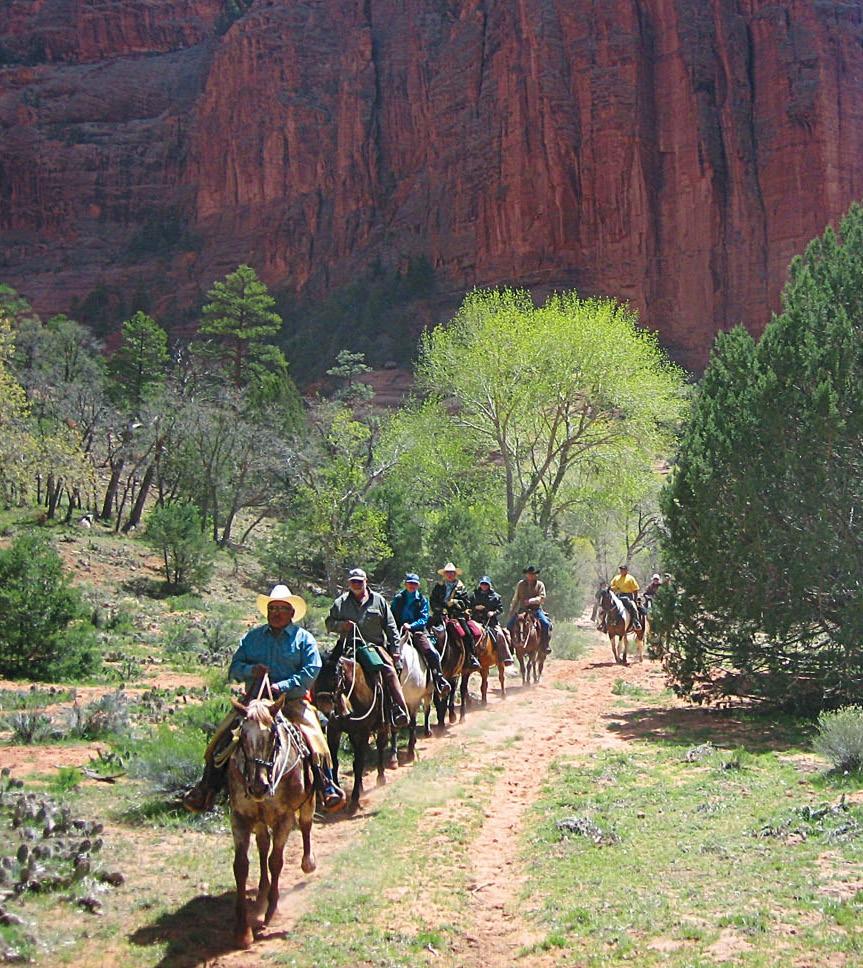
3 minute read
Getaways
Explore Canyon de Chelly
“What began as a trail-riding adventure with friends and family became a spiritual journey through a mystical land,” writes Christine Duval-Sentry of Canyon de Chelly National Monument. Shown are Anasazi petroglyphs.
Plan now for a future equestrian adventure in Canyon de Chelly National Monument in northeast Arizona. Article and Photos by Christine Duval-Sentry
Editor’s note: At this writing, the Navajo Nation is reporting the highest per-capita COVID-19 infection rate in the United States. The Navajo Nation Department of Health has established a COVID-19 fund to help the Navajo Nation respond to the pandemic. To donate, click here. Canyon de Chelly National Monument is currently closed to visitors. Check the NPS website (nps.gov) for updates. For updates on the overall NPS response to COVID-19, go to nps.gov/ coronavirus.
Stunning Destination
Canyon de Chelly National Monument, which is located in the heart of the Navajo Nation in northeast Arizona, near Chinle. The labyrinth monument is made up of four gorges: Canyon de Chelly; Canyon de Muerto; Black Rock Canyon; and Monument Canyon. Canyon walls rise to more than 1,000 feet above the floor. Elevation ranges from 5,500 feet to just over 7,000 feet above sea level. >>
“Along the way, we stopped at significant archeological sites, and gathered round to hear stories about Navajo culture and Anasazi history from our Navajo guides,” reports Duval-Sentry.

Rich History
Anasazi (a Navajo word meaning “the ancient ones”) inhabited the canyon for about 600 years, from tographs; petroglyphs; and pottery shards. Since the 1700s, the Navajo Nation has inhabited these lands. In 1931, Canyon de Chelly National Monument was established to preserve archeological ruins and their record in human history. Embracing 84,000 acres within the Navajo Reservation and comprised entirely of Navajo Tribal Trust Land, the monument is administered by the National Park Service in partnership with the Navajo Nation.
“The network of sandstone passages and beautiful sheer walls served as our backdrop for four full days of riding,” writes Duval-Sentry.

about 700 to 1300 AD. Evidence of their existence can be seen throughout the canyon: homesites tucked into the canyon walls; pic
Horse Camping
You can trailer in your own horse. For information on overnight horse camping and private livestock use, contact the Navajo Parks & Recreation Department (928/674-2106). For a downloadable trip-planning guide, click here.
Guide Services
To enter the monument, you must be accompanied by an authorized Navajo guide. The park requires one guide per 10 riders.
Canyon Trails
We rode out from camp into the
To enter Canyon de Chelly National Monument, you must be accompanied by an authorized Navajo guide.

canyon mouth. As we rode deeper into the canyon, the sheer cliffs got higher and higher. We rode primarily along a wash, sloshing through water. Along the way, we stopped at significant archeological sites, and gathered round to hear stories about Navajo culture and Anasazi history from our Navajo guides. Next, we rode to Standing Cow Ruins where the Navajo etched drawings into the canyon walls depicting the Spaniards’ arrival in the late 1700s. Twenty-three miles later, we arrived back at camp.
The second day, we rode to White House ruins, the second largest Anasazi ruins in the canyon. Occupied about 1,000 years ago, it’s the only place in the canyon that visitors can see without a guide— after hiking down from the rim about 500 feet. Our final destination was Mummy Cave, the largest Anasazi ruins site.
Best Seasons
The best times of the year to ride in Canyon de Chelly are late fall and spring. In the summer, temperatures can climb to the triple digits; in the winter, it may snow. USR









